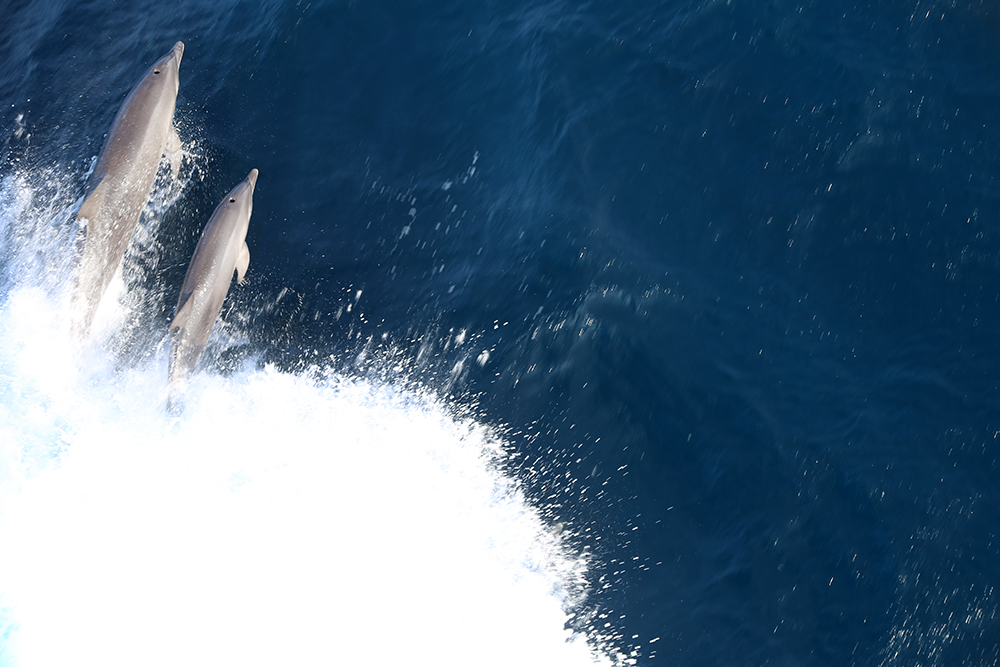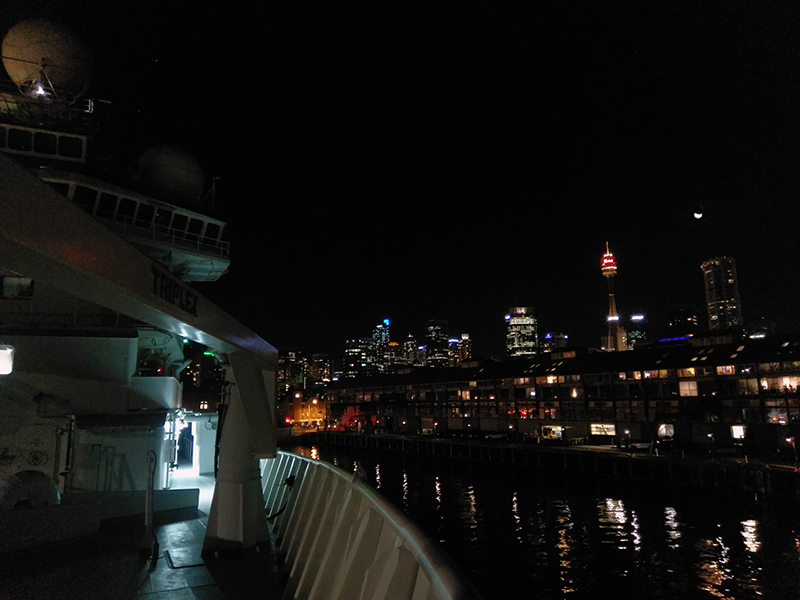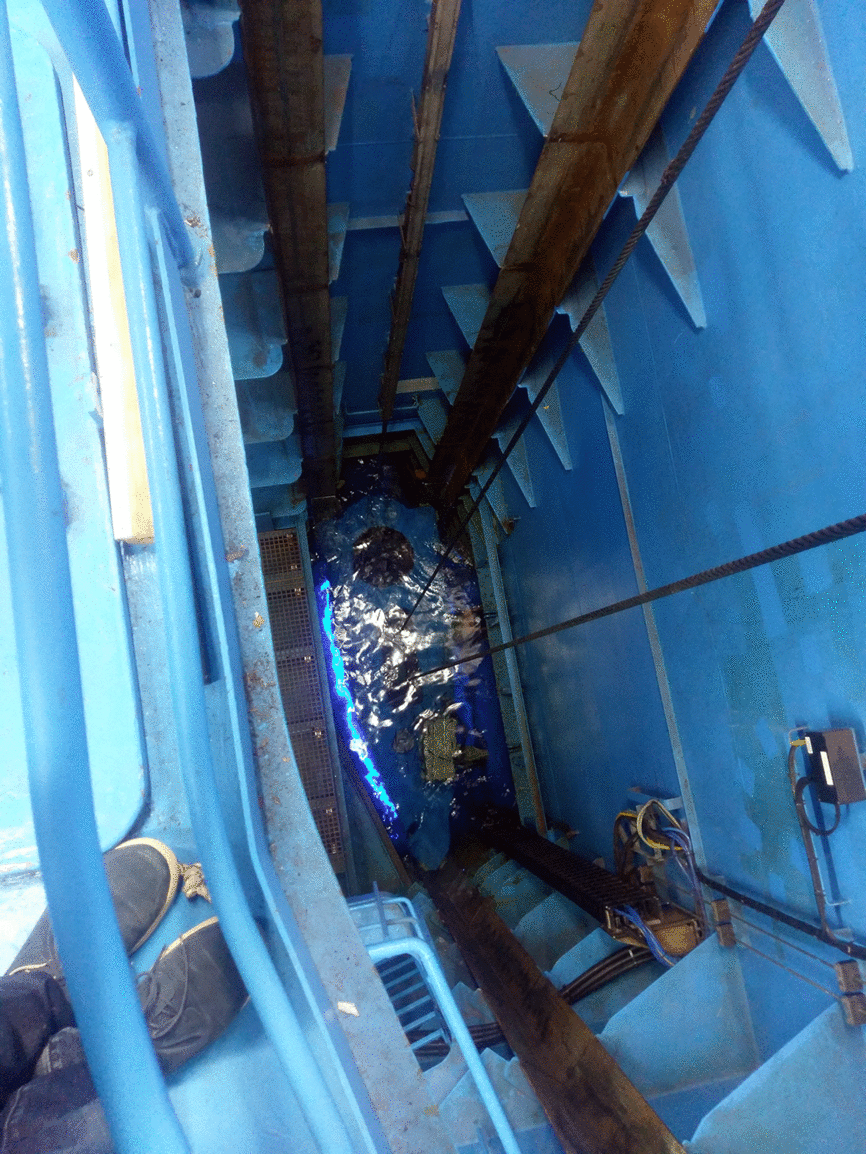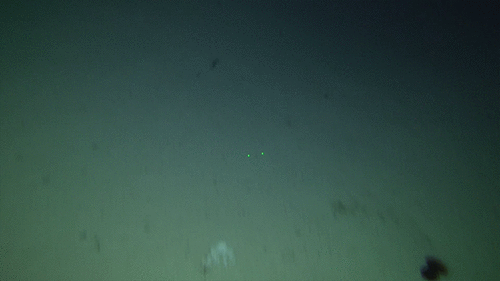Feature image GIF, Katie Walters. Above, mother and calf bottlenose dolphins skipping along the bow over the weekend. Photo: Jesse Hawley.
We’re already half-way through the voyage and there’s a lot to catch you up on. But before we get to the sweet science part of this entry, let me give you a fast-forward run through of what’s happened so far. If you haven’t already, feel free to read my first blog here.
Catch up
It’s not voyeurism if you’re on a research voyage. (Woolloomooloo.)
Already it’s been a week since Investigator snuck out of Port Jackson on Sunday night. Around 8 pm the ship was towed out silently, sliding through the waters of Woolloomooloo with us standing on the foredeck in the dark, passing by the glass-fronted lounge rooms lit up by TVs. Those of us who’d never been on a voyage crowded outside excitedly, whispering about dolphins and tropics, mega waves and seasickness. We took pictures and hopped about while the rest of the crew got on with work inside.
With so many new experiences our sense of time dilated. Our first full day, along the coast to Newcastle, seemed to last a week: rolling out of bed to eat breakfast with dozens of familiar-faced strangers, also sleepy-eyed, getting calf-affirming tours up and down the ship’s ten decks, a seemingly infinite number of photo, panorama, and video opportunities, drills – the crew practicing our sample core deployment for the next week, work, and animal spotting: thousands of seabirds, hundreds of humpbacks, and dozens of dolphins all in one day. Inside the ship, the novelty of every ad hoc gizmo, every lino and science-scented passage, the sense that you’re conducting work in a giant elevator pressing gravity down at the bottom, removing it at the top, and outside the ship, an unwavering twelve hour Sun that appeared to be stuck in the sky all stretched out our first impressions, endless like the circular blue horizon.
Yes there’s a room in the ship (next to the kitchen [galley]) that has shafts leading to pools of ocean. Lights on. Lights off.
Knowing nothing about ships, or how to keep dozens of people alive for months at a time, this was all fascinating, but what truly floated my boat was the ability of the ship, its scientific instruments and the people on board who wielded them like extensions of their thoughts.
SIT GSM DAP
They’re not moves in a hip-hop dance routine*, they’re acronyms for the science teams on board Investigator. (*I don’t know what hip-hop is.)
You want to do science at sea? You need equipment, you need to use it to collect data, and you need to make those data legible for others. They’re the teams in that order — SIT: Seagoing Instrumentation Tech, GSM: Geophysical Survey Mapping, and DAP: Data Acquisition and Processing. There’s also the hydrochemistry lab who analyse the seawater to make sure everything’s in check. These teams are on board Investigator for every voyage. They prepare the equipment and deploy it; work, upgrade, update, and preserve it. (There’s some Missy Elliott for you). They work hand-in-hand with the other scientists and research expeditions on board to provide them with the data they need for their studies, while also contributing to publicly accessible data on Australia’s composition: its air, oceans, and rocky body.
Aaron from SIT
I had a chat with Aaron Tyndall in the SIT team, who had previously given us a whirlwind tour of the ship’s on board instrumentation.
Aaron from SIT, testing out a custom-built beacon brace for the deep towed camera.
“I’m a Seagoing Instrumentation Technician. My role is to look after all the scientific equipment on board RV Investigator. Maintain it. Operate it. Build new platforms to deploy. My favourite piece of tech is the camera. I love the camera because…I helped build it. At the moment we can send it down 2,500 metres. It’s got three different cameras: a high definition still, high def video, pal look-ahead video, a CTD, altimeter, pressure sensor, and lights and lasers. Everybody loves lasers. And all of which we control and get live feeds from from the ship.
“I start my shift at 2 am, go to sleep at 2 in the afternoon. And yes – the ship’s cradle-like rocking helps me get to sleep. The large sea shuddering does not.
“What impresses me most about the ship? I think the most impressive part is the DP, Dynamic Positioning, system. It allows the ship to hold or change position with amazing accuracy. I can ask the bridge to hold station and it will, with pinpoint accuracy. I can ask the bridge to move five metres east, and this large ship on a moving surface being blown about by the wind, and it does, almost to the centimetre.”
Aaron likes the camera. Let’s talk about the camera.
Deep towed camera
On one of its most recent voyages, RV Investigator went to the Eastern Abyss, a deep sea plain down thousands of metres. Thanks to the crew, like Aaron, for constructing the camera, the scientists were able to watch a live feed of that abyss. That’s where we get the inky footage of those ghostly blobs and ghoulish streamers of fish.
The camera’s deployed while the ship’s still on the move over the wave tops. Investigator lowers the camera (on a frame) via a winch, down into colder waters until it reaches the desired depth. Once down, the cameras start rolling, capturing footage and transmitting it as light through fibre optic cables, glass hairs that stretch thousands of metres from down in the abyss up to the ship. From here, the SIT team has rigged the live footage to hook up with the ships ethernet, allowing everyone, from the bridge to the lounge room to the mess hall to watch abyssal footage live.
Unforeseen obstacles flying at depths. The video this GIF was taken from was called ‘Big Damn Rock’.
What if the camera is gliding along the bottom and approaches a dirty big rock? The crew have hooked up the winch mechanism to a remote control board that looks and acts like the joystick on a one-dimensional skill tester. You can move the camera up and down in the water column, roughly one metre per second. And with visibility of just 15 – 20 metres ahead, it gives you ~10 seconds to respond. You’re playing the skill tester to keep, not win, your prize.
Etymology break: log, knots, web, and blogs
A question for you, computer user: Why do you ‘log in’ to a computer? And why are blogs called, unsoundly, ‘blogs’?
And, since I’m on a ship, why do we use ‘knots’ not kilometres per hour?
In ye olden days, before odometers and speedos, ships needed to know how fast they were travelling. Their solution? They’d get a piece of rope and tie knots in it at regular intervals, say every 10 metres, then tie it around a log and toss it over board. They’d time how long it took for each knot to pop over the side, and boom, you’ve got speed. How do you keep tabs of the knots? You write it in a book. What type of book? The book that keeps the ‘log numbers’ in it: the log book.
And what’s a ‘blog’? It’s a web+log.
So, in a poetic tying of loose ends, I’m on a ship like our seagoing forebears where the log originated, keeping a web log, not of knots, but deep tow cameras and their modern day equivalents.
Next blog
Next blog I’ll be chatting about some of the animals we’ve seen so far (strap yourself in for a shower of boobies and shearwaters), and some of the other tech on board RV Investigator. Read the third and final blog right here.
STEM education on RV Investigator
Find out more about some of our education programs on board, here.







8th October 2017 at 11:18 am
Hi Jesse, hope you’re enjoying the trip. Great blogs, look forward to the next one.
7th October 2017 at 1:41 pm
Hi Jesse and Investigator crew,
Very jealous of your position 🙂 This blog is great to follow and I look forward to seeing and reading about the research being done in our Australian waters by CSIRO and associates. Keen to let students know about research options both on land and the water that is occurring now. Love the videos and looking forward to live casts if possible.
7th October 2017 at 1:58 pm
Hi there Kathy,
Thank you very much for your lovely sentiments. Australian marine science, and that done on RV Investigator, is as exciting as it is significant. I’ve almost finished the third and final blog, which has a partial focus on communicating to students, so be sure to stay tuned. Thanks for reading 🙂
Jesse